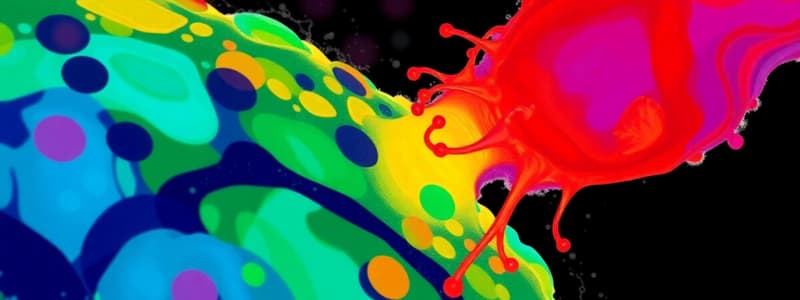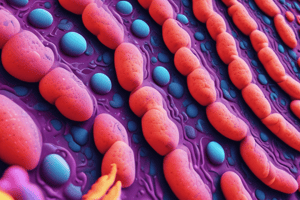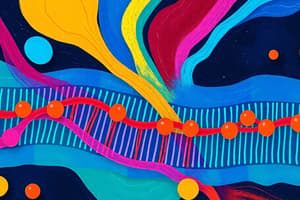Podcast
Questions and Answers
What is the primary function of transport proteins in cell membranes?
What is the primary function of transport proteins in cell membranes?
- To maintain the cell's shape and volume
- To facilitate the movement of molecules across the membrane (correct)
- To form the structural framework of the cell
- To create energy in the form of ATP
How does passive transport differ from active transport?
How does passive transport differ from active transport?
- Both types of transport rely solely on carrier proteins
- Active transport moves molecules along a concentration gradient while passive transport moves against it
- Passive transport requires energy while active transport does not
- Passive transport does not require energy while active transport does (correct)
Which type of transport protein is responsible for moving molecules against the concentration gradient?
Which type of transport protein is responsible for moving molecules against the concentration gradient?
- Channel protein
- Carrier protein (correct)
- Facilitated diffusion protein
- Simple diffusion protein
What are the three forms of endocytosis?
What are the three forms of endocytosis?
What distinguishes a symporter from an antiporter in terms of transport?
What distinguishes a symporter from an antiporter in terms of transport?
Flashcards
Passive Transport
Passive Transport
Movement of molecules across the cell membrane from high concentration to low, without energy input.
Active Transport
Active Transport
Movement of molecules across the cell membrane from low concentration to high using energy (ATP).
Facilitated Diffusion
Facilitated Diffusion
Passive transport using channel proteins to move molecules from high to low concentration.
Endocytosis
Endocytosis
Signup and view all the flashcards
Carrier Protein
Carrier Protein
Signup and view all the flashcards
Study Notes
Cell Membrane and Transport
- The cell membrane is composed of a phospholipid bilayer and transport proteins (transmembrane proteins).
- Transport proteins can be channel proteins or carrier proteins.
Cell Transport
- Cell transport is the movement of substances across the cell membrane.
- Molecules transported include oxygen, carbon dioxide, water, sodium, potassium, glucose, protein, and starch.
- Cell transport mechanisms are categorized as passive and active transport.
Passive Transport
- Passive transport involves movement along a concentration gradient (high to low concentration).
- Passive transport does not require energy (ATP).
- Types of passive transport include facilitated diffusion, simple diffusion, and osmosis.
- Facilitated diffusion requires a channel protein to move molecules.
- Simple diffusion involves movement of molecules down a concentration gradient without a protein.
- Osmosis is the movement of water molecules from high to low concentration across a semipermeable membrane.
Active Transport
- Active transport requires energy (ATP) to move molecules against a concentration gradient.
- Types of active transport include ion pumps (symport, antiport), endocytosis, and exocytosis.
- Carrier proteins can be symporters or antiporters.
- A symporter moves two different molecules in the same direction.
- An antiporter moves one molecule in one direction and another in the opposite direction.
Endocytosis
- Endocytosis is when a cell membrane engulfs fluids and large molecules to bring them in.
- Forms of endocytosis include pinocytosis (cell drinking), phagocytosis (cell eating), and receptor-mediated endocytosis (bulk acquisition).
Studying That Suits You
Use AI to generate personalized quizzes and flashcards to suit your learning preferences.





